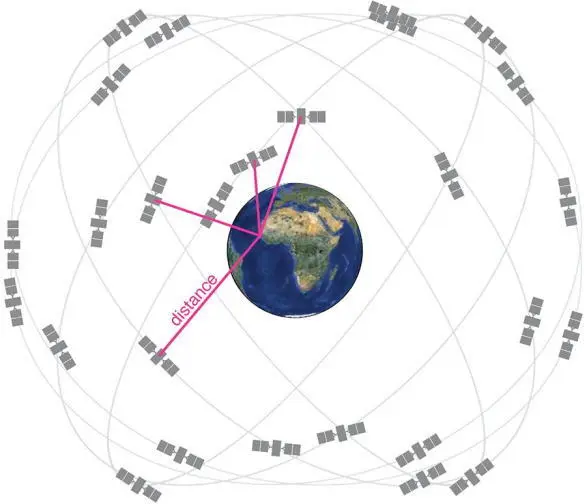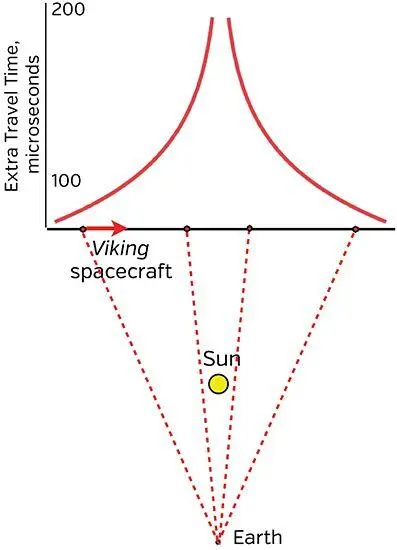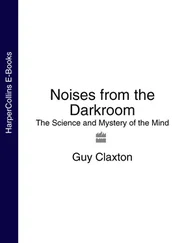This scheme would fail if the signal transmission times were the true times measured on the satellite. Time at a 20,000-kilometer height flows more rapidly than on Earth by forty microseconds each day, and the satellites must correct for this. They measure time with their own clocks, then slow that time down to the rate of time flow on Earth before transmitting it to our phones.

Fig. 4.2. The global positioning system.
Einstein was a genius. Perhaps the greatest scientist ever. This is one of many examples where his insights about the laws of physics could not be tested in his own day. It required a half century for technology to improve enough for a test with high precision, and another half century until the phenomena he described became part of everyday life. Among other examples are the laser, nuclear energy, and quantum cryptography.
The Warping of Space: The Bulk and Our Brane
In 1912 Einstein realized that if time can be warped by massive bodies, then space must also be warped. But despite the most intense mental struggle of his life, the full details of space warps long eluded him. From 1912 to late 1915 he struggled. Finally in November 1915, in a great Eureka moment, he formulated his “field equation of general relativity,” which encapsulated all his relativistic laws including space warps.
Again, human technology was too puny for high-precision tests. [9] But see the first section of Chapter 24.
This time the needed improvements took sixty years, culminating in several key experiments. The one I liked best was led by Robert Reasenberg and Irwin Shapiro of Harvard. In 1976–77 they transmitted radio signals to two spacecraft in orbit around Mars. The spacecraft, called Viking 1 and Viking 2 , amplified the signals and sent them back to Earth, where their round-trip travel time was measured. As the Earth and Mars moved around the Sun in their orbits, the radio signals traversed paths that were changing. At first, the paths were far from the Sun, then they passed near the Sun, and then far again, as shown in the bottom half of Figure 4.3.

Fig. 4.3. Travel time for radio signals from Earth to Viking to Earth.
If space were flat, the round-trip travel time would have changed gradually and steadily. It did not. When the radio waves passed near the Sun, their travel time was longer than expected, longer by hundreds of microseconds. The extra travel time is shown, as a function of the spacecraft’s location at the top of Figure 4.3; it went up and then back down. Now, one of Einstein’s relativistic laws says that radio waves and light travel at an absolutely constant, unchanging speed. [10] Unchanging after well-understood corrections for a bit of slowdown due to interaction with electrons in interplanetary space—so-called “plasma corrections.”
Therefore, the distance from Earth to the spacecraft had to be longer than expected when passing near the Sun, longer by hundreds of microseconds times the speed of light: about 50 kilometers.
This greater length would be impossible if space were flat, like a sheet of paper. It is produced by the Sun’s space warp. From the extra time delay and how it changed as the spacecraft moved relative to Earth, Reasenberg and Shapiro inferred the shape of the space warp. More precisely, they inferred the shape of the two-dimensional surface formed by the paths of the Viking radio signals. That surface was very nearly the Sun’s equatorial plane, so I describe it that way here.
The shape that the team measured, for the Sun’s equatorial plane, is shown in Figure 4.4 with the magnitude of the warping exaggerated. The measured shape was precisely what Einstein’s relativistic laws predict—precise to within the experimental error, which was 0.001 of the actual warping, that is, a part in a thousand. Around a neutron star, the space warp is far greater. Around a black hole, it is enormously greater.
Now, the Sun’s equatorial plane divides space into two identical halves, that above the plane and that below. Nonetheless, Figure 4.4 shows the equatorial plane as warped like the surface of a bowl. It bends downward inside and near the Sun, so that diameters of circles around the Sun, when multiplied by π (3.14159…), are larger than circumferences—larger, in the case of the Sun, by roughly 100 kilometers. That’s not much, but it was easily measured by the spacecraft, with a precision of a part in a thousand.
How can space “bend down”? Inside what does it bend? It bends inside a higher-dimensional hyperspace, called “the bulk,” that is not part of our universe!
Let’s make that more precise. In Figure 4.4 the Sun’s equatorial plane is a two-dimensional surface that bends downward in a three-dimensional bulk. This motivates the way we physicists think about our full universe. Our universe has three space dimensions (east-west, north-south, up-down), and we think of it as a three-dimensional membrane or brane for short that is warped in a higher-dimensional bulk . How many dimensions does the bulk have? I discuss this carefully in Chapter 21, but for the purposes of Interstellar , the bulk has just one extra space dimension: four space dimensions in all.
Now, it’s very hard for humans to visualize our three-dimensional universe, our full brane, living and bending in a four-dimensional bulk. So throughout this book I draw pictures of our brane and bulk with one dimension removed, as I did in Figure 4.4.

Fig. 4.4. Paths of Viking radio signals through the Sun’s warped equatorial plane.
In Interstellar , the characters often refer to five dimensions. Three are the space dimensions of our own universe or brane (east-west, north-south, up-down). The fourth is time, and the fifth is the bulk’s extra space dimension.
Does the bulk really exist? Is there truly a fifth dimension, and maybe even more, that humans have never experienced? Very likely yes. We’ll explore this in Chapter 21.
The warping of space (warping of our brane) plays a huge role in Interstellar. For example, it is crucial to the very existence of the wormhole connecting our solar system to the far reaches of the universe, where Gargantua lives. And it distorts the sky around the wormhole and around the black hole Gargantua; this is the gravitational lensing we met in Figure 3.3.
Figure 4.5 is an extreme example of space warps. It is a fanciful drawing by my artist friend Lia Halloran, depicting a hypothetical region of our universe that contains large numbers of wormholes (Chapter 14) and black holes (Chapter 5) extending outward from our brane into and through the bulk. The black holes terminate in sharp points called “singularities.” The wormholes connect one region of our brane to another. As usual, I suppress one of our brane’s three dimensions, so the brane looks like a two-dimensional surface.

Fig. 4.5. Black holes and wormholes extending out of our brane into and through the bulk. One space dimension is removed from both our brane and the bulk. [Drawing by the artist Lia Halloran.]
Читать дальше
















